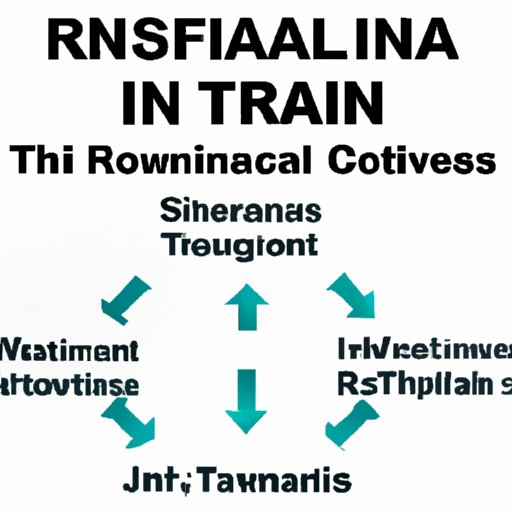
I. Introduction
Withdrawing money from your IRA can have significant implications on your retirement savings and taxes. As you plan for retirement, it is important to understand the rules and strategies related to IRA withdrawals. This article aims to provide a comprehensive guide to understanding IRA withdrawals, including the basics, exceptions to early withdrawal penalties, required minimum distributions, differences between Traditional and Roth IRAs, planning for retirement, and tips for managing your withdrawals.
II. The Basics: Understanding IRA Withdrawals and Their Tax Implications
IRA, or Individual Retirement Account, is a type of savings account that allows individuals to save for retirement with tax benefits. There are two main types of IRAs: Traditional IRA and Roth IRA. A Traditional IRA offers tax-deferred growth, meaning you don’t pay taxes on the money you contribute until you withdraw it. On the other hand, a Roth IRA offers tax-free growth, meaning you pay taxes on the money you contribute upfront, so you don’t have to pay taxes on qualified withdrawals in retirement.
Withdrawal rules for Traditional and Roth IRAs differ based on their tax implications. For Traditional IRAs, withdrawals made before age 59 1/2 are subject to a 10% early withdrawal penalty on top of ordinary income taxes. In contrast, qualified withdrawals from Roth IRAs can be made at any time and are tax-free.
It is essential to understand the tax implications of IRA withdrawals. Withdrawals from Traditional IRAs are considered ordinary income, which means they are taxable at your marginal tax rate. This tax rate can be higher than the capital gains rate applied to withdrawals from taxable investment accounts. Therefore, withdrawals from Traditional IRAs can significantly impact your taxes and retirement savings.
III. Exceptions to Early Withdrawal Penalties: When You Can Take Money Out Before Age 59 1/2
Withdrawing money from your IRA before the age of 59 1/2 will trigger a 10% early withdrawal penalty unless you meet specific exceptions. Qualifying reasons for taking early withdrawals include disability or death, qualified education expenses, medical expenses, and qualified first-time homebuyer expenses.
Additionally, several other exceptions apply to the early withdrawal penalty, such as higher education expenses, health insurance, and substantial equal periodic payments. It is essential to consult tax and financial professionals to ensure that you are eligible for an exception.
While the early withdrawal penalty can be waived with qualifying exceptions, it is crucial to consider the impact on your retirement savings. Early withdrawals reduce the principal amount of your retirement savings, which can jeopardize long-term financial security.
IV. Required Minimum Distributions: What You Need to Know About Taking Money Out After Age 70 1/2
After turning 70 1/2, you are required to take the minimum amount out of your traditional IRA each year. This is known as a Required Minimum Distribution (RMD) and is based on your age and account balance. Failing to take the RMD can result in a penalty of up to 50% of the required amount.
It is important to understand the calculation of RMDs and their tax implications. Failure to take the RMD can result in a significant tax liability due to additional income taxes and penalties.
V. Roth vs. Traditional IRAs: How the Rules for Withdrawals Differ
There are significant differences in the rules governing withdrawals from Roth and Traditional IRAs. While Traditional IRA withdrawals are subject to early withdrawal penalties and ordinary income taxes, withdrawals from Roth IRAs are tax-free and penalty-free if qualified.
Therefore, it is essential to understand the difference between the two types of accounts and their tax implications when deciding which account to contribute to or withdraw from. Additionally, it is crucial to consider personal circumstances and future tax rates to maximize retirement savings.
VI. Planning for Retirement: Strategies for Making Withdrawals from Your IRA
Having a withdrawal strategy is crucial to maximizing retirement savings and minimizing the impact of taxes. When planning withdrawals, several factors should be considered, such as anticipated tax rates, RMD amounts, and other income sources.
There are several tools and resources available to help with planning for retirement withdrawals, such as retirement calculators and tax professionals. Seeking professional advice can ensure that you make informed decisions regarding your withdrawal strategy.
VII. How to Avoid Costly Mistakes When Taking Money out of Your IRA
Common mistakes made when taking money out of IRAs include failing to take RMDs, making early withdrawals without penalty exceptions, and not considering tax implications. These mistakes can result in significant penalties, taxes, and reduced retirement savings.
Consulting with financial and tax professionals can help avoid costly mistakes when making withdrawals from your IRA. By seeking expert advice, you can ensure that you are maximizing your retirement savings and minimizing the impact of taxes.
VIII. Maximizing Your Retirement Savings: Tips for Managing Your IRA Withdrawals
Managing your IRA withdrawals is critical to maximize your retirement savings and balance your income sources. Tips for managing withdrawals include planning for RMDs, considering taxes and penalties, and seeking expert advice.
Additionally, strategies such as converting from a Traditional IRA to a Roth IRA can help to manage future taxes and maximize retirement savings. Again, consulting with tax and financial professionals can help to develop a plan tailored to your personal needs and circumstances.
IX. Conclusion
IRA withdrawals can have a significant impact on your retirement savings and taxes. It is essential to understand the rules governing withdrawals, including exceptions to penalties and RMDs. Additionally, having a withdrawal strategy and seeking professional advice can help maximize your retirement savings and avoid costly mistakes.
By understanding the basics of IRA withdrawals and developing a withdrawal strategy tailored to your personal circumstances, you can ensure that you are making informed decisions that will help you achieve your retirement goals.




